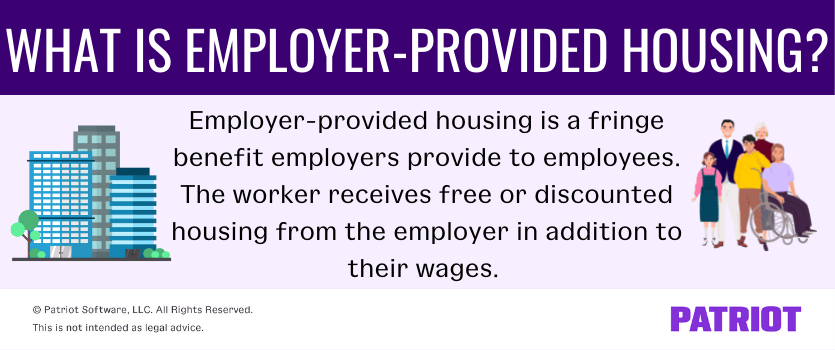Paying for your employees’ housing—say what? It’s one of many perks you may look at when looking for ways to attract, hire, or retain employees. On your list of potential benefits are probably things like health insurance, retirement plans, and work-from-home opportunities. Although not as common, employer-provided housing is another option to mull over. Get the scoop on what it is, how it works, pros and cons, taxability, and more.
What is employer-provided housing?
Employer-provided housing is a perk some employers offer eligible employees. The benefit can be free or discounted housing in addition to or in place of wages. However, jobs with room and board provided cannot pay employees only in free housing. So, you cannot entirely provide housing in lieu of wages.
Housing provided by employers is a taxable fringe benefit. But, there are some exceptions under federal law. The specific circumstances of jobs that pay for housing determine if the benefit is taxable and, if so, how much is subject to taxes. You must follow all employer-provided housing laws.

Is employer-provided lodging always taxable?
Again, the taxability of housing-provided jobs depends on the specific circumstances of the housing. Not all employer-paid housing is taxable.
Housing as a fringe benefit
If an employer provides housing as a fringe benefit to attract or retain employees, the IRS considers the value of the lodgings a taxable benefit. It is taxable income for the employee. This includes both housing that an employer pays for and housing allowances.
Do you offer a choice between additional pay or housing to your employees? If so, the lodging is taxable because there is a choice.
Housing as a nontaxable exception
The IRS allows employers to exclude the value of lodging in three specific circumstances:
- Housing is on business premises
- Lodgings are offered for the employer’s convenience
- Employees must accept housing as a condition of employment
Housing on the business premises is generally also the employee’s place of work. The lodging you provide to employees must be living quarters that are essential for your business. Simply owning the property is not enough to qualify. Examples include household employees living in your home (e.g., nannies).
Lodgings offered for the employer’s convenience depend on the facts and circumstances to qualify as an exclusion. Employers must have a substantial business reason for providing housing to the employee that’s more significant than just giving additional pay. A written statement is insufficient for proof. Provide additional details that prove a substantial business reason for providing housing to an employee.
Housing as a condition of employment meets the test for taxable exclusions if an employer requires the employee to accept it to properly perform their work duties. Examples of these conditions include individuals who must be available at all times and could not otherwise carry out their work without lodging.
Taxes on housing provided by employers
Don’t meet the IRS requirements to exclude the provided housing from your employees’ wages? You need to know how to tax your employee’s housing as a fringe benefit.
Fringe benefits are subject to the following taxes:
- Federal income tax
- Social Security tax
- Medicare tax
- Federal unemployment (FUTA) tax
Report the fringe benefit’s fair market value (FMV) in Boxes 1, 3, and 5 on the employee’s Form W-2, Wage and Tax Statement. If the employee pays any portion of the housing allowance, deduct their payments from the amount you report on their W-2 form.
The employee reports the amount on Line 7 of their Form 1040, U.S. Individual Income Tax Return. Line 7 reports capital gains or losses. Employees do not have to use Schedule D to complete this line.
What is the fair market value? According to the IRS, you must use the general valuation rule to determine the value of most fringe benefits. The FMV is not the amount the employer or employee determines to be the value of the housing. Instead, employers may determine the fair market value of housing by:
- Searching the value of similar housing in the same area
- Requesting valuation of the housing from a realtor
- Acquiring an appraisal of the property
FMV is the amount of money the employee would have to pay an independent third party to buy or lease the property.
Clamoring for all the latest information in payroll?
Get the latest payroll news delivered straight to your inbox.
Subscribe to Email ListExample of taxing employer-provided housing
Say you offer taxable housing to your employee as a fringe benefit. You do your research and discover that the property’s fair market value is $1,000 per month. For the entire year, the benefit’s value is $12,000 ($1,000 X 12).
The employee earns $2,000 per month in wages. Their annual wages are $24,000 (12 X $2,000).
Add the $12,000 in housing to the employee’s $24,000 of wages. The total amount of taxable wages on the employee’s W-2 form is $36,000 ($12,000 + $24,000). The employee must pay federal income, Social Security, and Medicare taxes on $36,000. And, the employer must pay Social Security and Medicare taxes on the $36,000 in wages.
Do states have laws about taxing employer-provided housing?
Only California imposes taxes on employer-provided housing, including housing the federal government excludes. However, the state does not levy state income tax on the provided housing.
Employers must pay state unemployment insurance (SUI) and the Employment Training Tax (ETT) on the value of the housing. And, they must calculate and withhold State Disability Insurance (SDI) from the employee’s wages.
Unlike federal laws, California does not tax the total amount of the fair market value of the employer-provided lodgings. Instead, the state taxes two-thirds of the FMV of the property where an employee lives for free or at a discounted rate.
Employers report the two-thirds amount on the employee’s Form W-2 in Box 14 as housing allowance. Box 14 is for informational purposes only.
To report the ETT, SDI, and SUI to the state, employers report the two-thirds value on Forms DE9 and DE9C as part of regular wages subject to the taxes. On Form DE9C, only include the amounts in the Total Subject Wages field. Do not include the amount in the state income tax box.
Employees as tenants
You are essentially creating a landlord-tenant agreement by providing property to your employees. So, create a signed agreement with each applicable employee.
Not sure where to start? Check with your state regarding tenancy laws. And, consider consulting a small business lawyer to draft the agreement.
This is not intended as legal advice; for more information, please click here.


